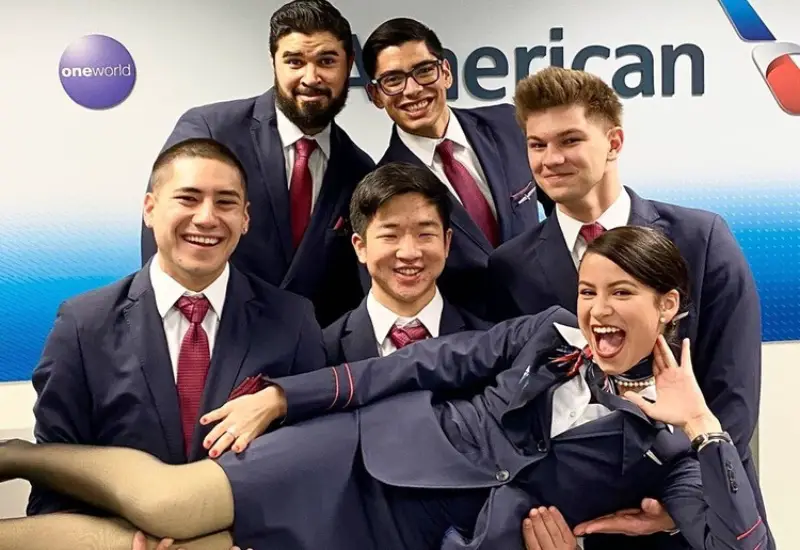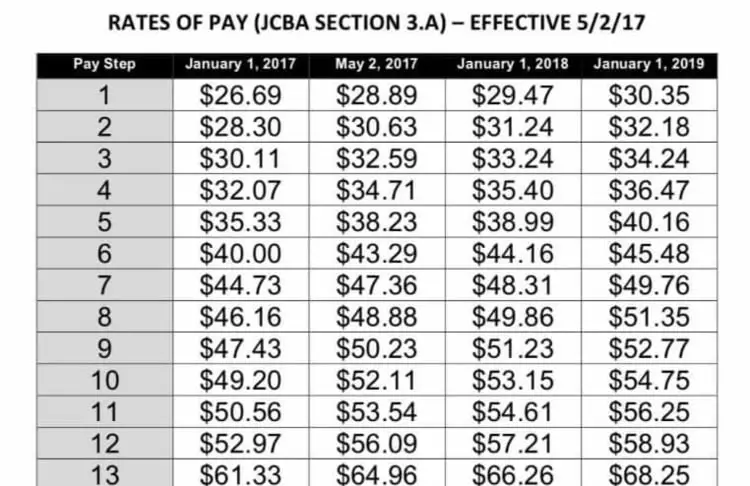
American Airlines is one of the highest paying of any company in the US for flight attendants. For this article, I spoke to a lot of my colleagues, asking them questions about their rates of pay and the way it works for them within American Airlines.
So here are the results of that research, a view from the frontline of the flight attendant’s world.
But just a heads up here; it has to be said that your first year with any airline is going to be a financial challenge.
Flight attendants with American Airlines start out at $30,000 – $56,000. This includes payment for their flight hours, layover payments and any other bonuses. Highly experienced flight attendants with American Airlines can make up to $80,000 per annum or more.
So, as you can see, there is a big difference between the lowest and highest salaries paid to flight attendants. That’s why it’s not easy to give a definitive number because so many factors come into play;
Things like seniority, how many hours you fly per month and your position in the hierarchy, are all elements that affect the pay level of an individual staff member.
So let me walk you through the different considerations that affect what pay rate a flight attendant is on.
Table of Contents
Salary Is Tied to Seniority
This is the most important factor of all. Seniority really matters.
The more hours you work, or the more senior your position is, the higher the salary you will get.
It’s not just your paycheck, but the system for assigning cabin crew to flights is also based on seniority, as are the days off that you will be granted.
So, as with all other aviation companies, in American Airlines, your salary is tied directly to your seniority.
And the good part about that is that you will receive guaranteed annual pay raises.
As a new-hire, you will get a mandatory pay raise after your 6 months of probationary employment, and after that an increase each year.
American Airlines Flight Attendant Career and Working Conditions
For the whole of your first year, you will be “on-reserve”.
This means that you will be on-call, and will need to be at your airport within 2 or to 3 hours.
For each of those reserve months, you will receive a schedule that will show the days that you are on-call and the days that you are off.
Usually, you’ll work 18 days on and have 12 days off.
What that means, is that in your first year as a flight attendant you are contractually obligated to be on-reserve, on-call, for 18 days in every month.
From the second year to the fourth, you will be on standby every other month.
And then, after the fourth year, you’re on-reserve for just one month and for the rest of the time you will hold a line. To hold a line simply means that you will be given monthly schedules of flying assignments, rather than be on-call.
This will be for 3 months until you are senior enough to always be off. Being “off” means that you are in the lucky position of always having flying assignments instead of being on standby.
Difference Between the Reserve vs Line Holder Pay?
While on reserve you have no idea when you’re going until you receive that phone call.
So you have no control at all over how much you earn or your hours worked.
Everyone starts on reserve in the USA, but the longer you work for the airline, the less likely it is that you will be placed on that duty.
In AA, after your first year on reserve, you’ll be able to hold lines (have a normal flight schedule) every other month.
This means that you’ll have the ability to bid for the specific trips you’d like to work, layovers, days off, etc. and you’ll have the option to drop or trade or pickup the trips you want or don’t want. So you’ll have more control over how much you earn and your schedule.
Okay, So let’s see how all that looks in real life.
| Up to 1 year seniority | Up to 4 years seniority | After 4 years seniority completed |
| Straight reserve | 1 month on (on-reserve) & 1 month off (holds a monthly schedule) | 1 month on (on-reserve) & 3 months off (holding a monthly schedule) |
It looks pretty tough at first glance, but it’s not really as bad as it seems.
There is a system that allows you to arrange your preferences in order of what you want.
This system is divided into 3 sections:
- Sequences
- Standbys
- RAPs.
So the day before you are on-reserve, every flight attendant can bid for:
- Sequences: basically these are the trips that other flight attendants have dropped or trips that haven’t been assigned to anybody
- Standby shift: 4-6 hours shifts where you sit at the airport and have to be available for an immediate assignment
- RAPs (Reserve Availability Periods): These are 12 hours shifts where you can be called on for assignment and must report to the airport within 2 hours. This applies to the airline’s DFW, ORD, STL, PHL, BOS, RDU bases.
Any other base that has a co-terminal airport has a 3-hour call out like LGA, MIA, LAX, SFO, DCA bases.
Co-terminal airports are a marketing facet of the aviation industry and this isn’t the place to explain them here. Just be aware that they are a part of the RAP section of being on reserve.
So being on standby is not as simple as the name suggests, there are variations on how this works. But, like all things new, you’ll get used to it and learn to work with it. Flight attendants are nothing, if not smart.
Okay, let’s move on from the slightly confusing world of scheduling and talk about something that is close to all our hearts. Money.
How Much Money Do American Airlines Flight Attendants Earn?
It depends on how many hours you fly and your seniority.
There’s that word again, seniority.
As a guide, this table below is the pay per-flight hour reviewed every year in American Airlines.
Pay per flight hour

The pay per flight hour is how much you get paid for every flying hour.
Which means from the moment the door of the plane closes before takeoff, to the moment the door opens again at the plane’s destination.
Using this pay scale, you can check how much you’ll get depending on your experience level.
For example, if you are a cabin crew starting out you will get $30.35 per flight hour (last column first step or year) and once you finish your “year of service” your pay step increases to $32.18 (last column second step or year) and so on until your 13th year.
Once you reach your 13th year you get paid $68.25 per flight hour. As you can see, there is a wide gap between the lowest and highest-earning flight attendants. But if you make it that far, can you imagine getting paid that amount per flight hour? Woo hoo!!
75 hours a month paid guaranteed when on-reserve
You won’t really know how many hours you will fly each month, but at least you are guaranteed a minimum of 75 hours a month on reserve/standby, even if they don’t call you to fly.
So even if you work less, you’ll always get paid 75 hours.
That’s got to be good, right?
So let’s say you fly 75 hours that month:
75 hours x $30.35 = $2,276
And remember that’s just for the flight hours.
If you’d like to earn more, you can choose to work on your off days. It’s your call.
So let’s say you only work 75 hours on reserve, but you pick up a 15-hour trip on your days off, you will be getting paid for 90 hours flight time.
And here’s the thing; if you work only 50 hours but you pick up a 15-hour trip, you will be working 65 hours but getting paid for 90 because your 75 guaranteed hours and not the 50 hours are added to that extra 15-hour trip that you picked up.
In some other airlines, it can be hard to pick up more trips, but with AA it’s quite easy to go above your 75 hour guarantee.
You can pick up as many hours as you want with AA.
You can fly until you drop if you want to.
Some people fly 110 or 120 hours. From experience, I have to tell you that although 75-80 flight hours a month might not seem a lot but you will feel tired and drained. So please don’t work yourself to death in order to earn that extra cash.
Bi-weekly pay – you’ll get paid twice a month
- The first pay will be on the 15th, and it will be “The Check”, the big one, the one that matters. It’ll include all the overtime you picked up on your days off, your “per diem”, premium pays plus any bonuses you have gained, like credit card commissions.
- The second pay on the 30th is always less. Your paycheck on that date will always total out to around $800 after taxes in the first couple of years. That’s because it’s your bare hourly pay.
K. Gonzalez, an AA flight attendant I spoke to says, “To help you get an idea, in my first-year, by flying 90 to 115 hours, I earned $2,300 on the 15th and $800 on the 30th but without the benefits and other charges taken out yet. If, like me, you fly a lot of 3 days trips, your per diem (layover pay) goes up a lot. I barely do turns (going to a destination and coming back in the day) and that helps a little”
Other Factors That Can Add to Your Paycheck
Per Diem
It’s what you get paid on your layovers, also when you are on standby, ready reserve.
This is $2.20 for domestic extra an hour for time away from your base and $2.50 for international.
It starts when you sign in and it ends when you get back to your base.
Don’t be fooled thinking that’s just a pittance, because it really adds up when you are having many 2, 3 or 4-day trips.
Plus in the US, per diems are considered tax-free. So whatever you receive is yours to keep if you’re employed by the airline in the said countries.
Deadhead
A deadhead is a paid, non-working flight in which the company needs to move a flight attendant from one city to another.
So every time your company needs to transport you to another base to work from (because, for example, you’re replacing someone that’s sick), or to bring you back to your base when you have finished your assignment, you travel as a passenger.
And the great part about that is that you’ll get paid the same amount as if you were working.
And that is really cool.
Lead Pay
There’s also a premium pay from $1.25-$3.25 extra per hour depending on your position in the flight sequence (FA1- Lead purser, Galley, etc.) and also depending on the aircraft (A321, B757).
Others
- Working holidays: there is also compensation of $75 for working on holidays.
- Credit card commissions: this is the money we get for opening or submitting airline credit card applications. If anyone fills one out and sends it in, we receive $50 for each approved application.
- LOD (Language Of Destination) speaker premium: extra $2 per flight hour. You will get the speaker premium if you are working flights that require flight attendants in the language that you are qualified in. But you won’t get the speaker premium on regular flights that don’t require a foreign language flight attendant. Nor you will get it on flights that require a language you aren’t qualified in.
Monthly Salary Examples
To help you evaluate your flight attendant career search, I’m giving you some examples:
Let me be honest, your first month will be rough. Your first paycheck on the 15th can be around $600- $800 and the second on the 30th around $900.
This is because of how the pay system works. For your first month, you are not getting paid any flight hours or any other extras as you just started with the company and all flights are paid one month behind.
The following months it gets better. You’ll get around $1,500 – 2,000 on the 15th ($2,300 maximum if flying lead and galley), and $600 – $800 on the 30th.
There are too many variables to come right out and say this is the flat rate, but it is a ballpark figure somewhere in that range, after taxes and flying as a reserve.
Once you become a line holder (senior enough to hold lines – flights – instead of being on reserve), you can make $3,000 a month after taxes in your second-year, flying 95-100 hours.
But as a new hire on-reserve, it’s highly unlikely that you’ll make $3,000. But it is possible, it just depends on your base and the time of the year.
Deductions and Taxes
All these numbers above were calculated without deductions, before taxes, uniform, 401k…
Based on that, you should take out 20% in tax (low balling) more or less $500 in taxes, including medical/dental/vision insurance, uniform and luggage ($30) costs and union dues.
Wrapping Up
Okay, that’s all the information I have for salaries at American Airlines this year. Perhaps next there will be improvements because airlines are in constant negotiations about flight attendant contracts. So things can change and I’ll try to keep you updated when they do.
Happy flying!



Awesome information!
How old are they hiring flight attendants?
There’s no maximum limit! Officially at least.
We’ve reviewed and commented on the AA requirements in this article if this can be useful to you and anyone else.
Thank you, you did an absolutely thorough job of explaining every detail. I was once a crew scheduler many years ago, and even I would have had a hard time explaining every detail as you have.
Thanks
Myron.
I truly enjoyed this, quick and good break down. I was with a regional and now mainline and this is good info for anyone doing research.
If a new flight attendant holds a bachelor’s degree, will they get paid a higher rate?
Hi Nicki, no it’s the same rate for everyone.